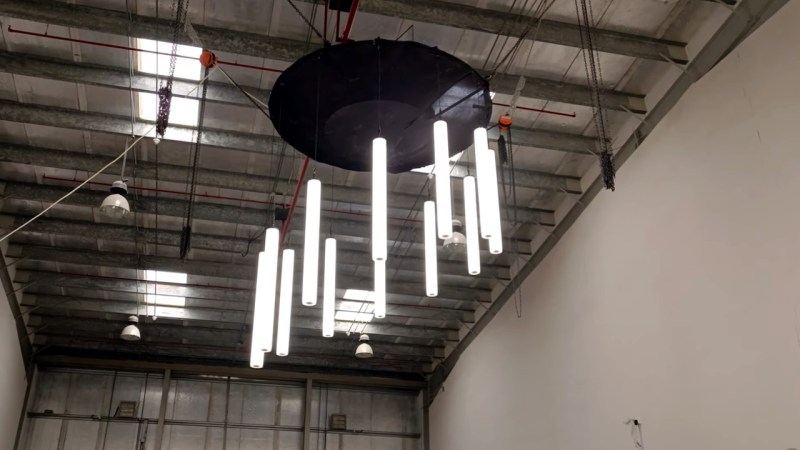We often say that hardware hacking has never been easier, thanks in large part to low-cost modular components, powerful microcontrollers, and highly capable open source tools. But we can sometimes forget that what’s “easy” for the tinkerer that reads datasheets for fun isn’t always so straightforward for everyone else. Which is why it’s so refreshing to see projects like this LED chandelier from [MakerMan].
 Despite the impressive final result, there’s no microcontrollers or complex electronics at work here. It’s been pieced together, skillfully we might add, from hardware that wouldn’t be out of place in a well-stocked parts bin. No 3D printed parts or fancy laser cutter involved, and even the bits that are welded together could certainly be fastened some other way if necessary. This particular build is not a triumph of technology, but ingenuity.
Despite the impressive final result, there’s no microcontrollers or complex electronics at work here. It’s been pieced together, skillfully we might add, from hardware that wouldn’t be out of place in a well-stocked parts bin. No 3D printed parts or fancy laser cutter involved, and even the bits that are welded together could certainly be fastened some other way if necessary. This particular build is not a triumph of technology, but ingenuity.
The video below is broken up roughly into two sections, the first shows how the motorized crank and pulley system was designed and tested; complete with various bits of scrip standing in for the final LED light tubes. Once the details for how it would move were nailed down, [MakerMan] switches over to producing the lights themselves, which are nothing more than some frosted plastic tubes with LED strips run down the center. Add in a sufficiently powerful 12 VDC supply, and you’re pretty much done.
As it so happens, this isn’t the first motorized lighting fixture that [MakerMan] has put together.

















It’s tempting to do something similar, but suspend fluorescent tubes with clear fishing line and power them inductively with a Tesla coil, giving the illusion that they are floating. Perhaps mounting the mechanism in the ceiling and just drilling tiny holes for the fishing line.
Too bad fluorescent tubes are banned by the EU now.
So they use 8 feet long (about 2.5M) LED tube that are compatible with old warehouse light fixtures?
Sure, but LED tubes don’t glow in HV electric fields, so the previous guy’s idea would not work.
They can if you give them enough capacitance and they’re the kind without a driver circuit. That’s how you get cheap bulbs glowing when switched off.
The deadline for T8 and T5 tubes is 2023-08-25, so there’s still some time left.
I am often impressed with what people design and show here.
Here I ask myself: who would like to have something like this in their room?
You would always be distracted by the movements – apart from the noise from the motor.
But there we are.
I guess you could raise and lower them with nitinol springs, but no doubt the power requirements would soon add up after extended runtime.
Depends on how fast you want to move them. Lower speed, less power, less noise, less distraction.
Agree. 10x slower would be imho nicer. Also, how long does the power cord last with all that flexing? Is wear an issue?
It’s stranded wire, not solid core, so it would flex for a long, long, long time…
Well, maybe. It depends a lot on the number of strands, their gauge and the coating. Tinsel wire is best…but you need to crimp to it, not solder. And CCA is Right Out!
Even slower would be better. Imagine a restaurant ceiling full of these, but moving at about one revolution per hour. It would take the guests quite some time to notice. But then it becomes a conversation topic :)
I wonder why people have colour changing LED’s in their room but yet they do.
An installation like this is nice for an institutional entrance lobby, staircase, hallway, etc: anywhere where many people come and gawk at it, but don’t have to do work for long enough to be distracted from it. (except the poor receptionist)
RGB or warm/cool color change? The latter helps mimic natural light over the day.
Cool mechanism. I worry about fatigue on the conductors cycling so many times over the pulleys.
An alternative: fixed light rods dim and brighten as unlit rods are moved up and down among them, much like fuel rods become critical as control rods are moved around them in a fission reactor.
Fatigue of conductors is a solved problem. Elevators and manufacturing robots are used every day.
The expected lifetime fully depends wether you use the correct wiretype for that purpose or not.
If you want truly lasting conductors, nitinol wire is superelastic and can withstand relatively large strains (10%) without fatigue.
….and that guy is welding without goggles. Brilliant.
Can it go slower. Real slow?